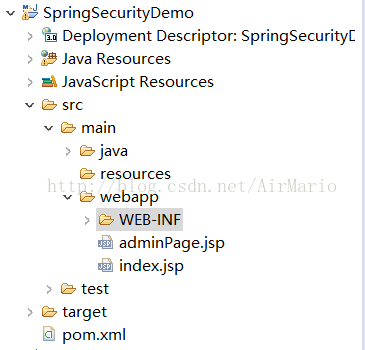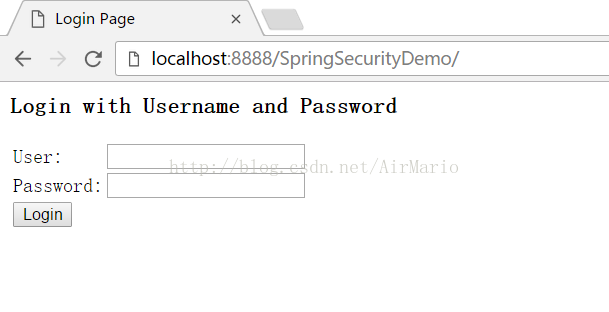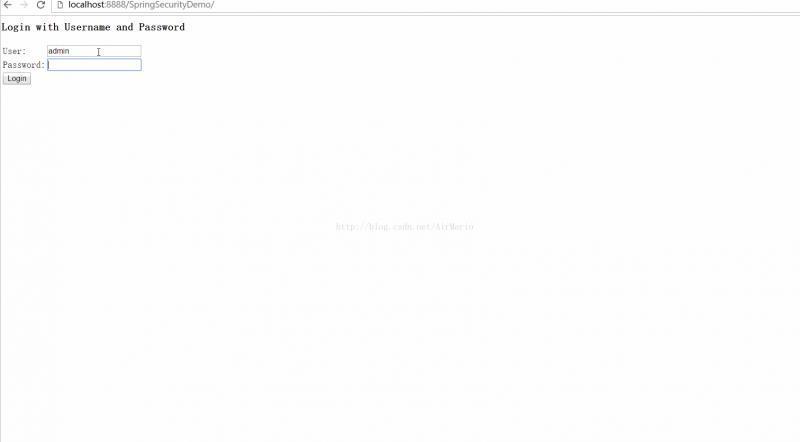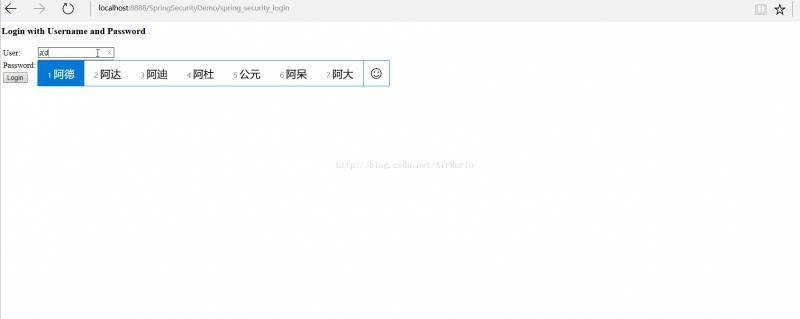Spring Security教程(一)
概要
Spring Security,这是一种基于 Spring AOP 和 Servlet 过滤器的安全框架。它提供全面的安全性解决方案,同时在 Web 请求级和方法调用级处理身份确认和授权。这里过多的spring security解释和作用就不在这里赘述了,请自行搜索。目前最新版本的Spring Security为4.2.2,但是我这里用了稳定版本3.1.3。下面例子为一个简单的Spring Security配置应用。
新建一个web maven项目
如果不知道怎么新建web maven项目的请参考我的另一篇博客: http://blog.csdn.net/AirMario...
新建好项目之后在webapp下添加了两个jsp文件,adminPage.jsp和index.jsp。其中adminPage.jsp只有那些拥有ROLE_ADMIN,ROLE_USER其中一种权限的用户才能访问,而index.jsp只允许那些拥有ROLE_USER权限的用户才能访问。

配置过滤器
为了在项目中使用Spring Security控制权限,首先要在web.xml中配置过滤器,这样我们就可以控制对这个项目的每个请求了。
web.xml
<?xml version="1.0" encoding="UTF-8"?>
<web-app xmlns:xsi="http://www.w3.org/2001/XMLSchema-instance"
xmlns="http://java.sun.com/xml/ns/javaee" xmlns:web="http://java.sun.com/xml/ns/javaee/web-app_2_5.xsd"
xsi:schemaLocation="http://java.sun.com/xml/ns/javaee
http://java.sun.com/xml/ns/javaee/web-app_3_0.xsd"
version="3.0">
<display-name>SpringSecurity</display-name>
<!-- 加载配置文件 -->
<context-param>
<param-name>contextConfigLocation</param-name>
<param-value>WEB-INF/config/applicationContext*.xml</param-value>
</context-param>
<!-- spring security 的过滤器配置 -->
<filter>
<filter-name>springSecurityFilterChain</filter-name>
<filter-class>org.springframework.web.filter.DelegatingFilterProxy</filter-class>
</filter>
<filter-mapping>
<filter-name>springSecurityFilterChain</filter-name>
<url-pattern>/*</url-pattern>
</filter-mapping>
<listener>
<listener-class>org.springframework.web.context.ContextLoaderListener</listener-class>
</listener>
</web-app>
Spring Security的配置
在WEB-INF/config/下新建applicationContext.xml,配置如下
<?xml version="1.0" encoding="UTF-8"?>
<beans:beans xmlns="http://www.springframework.org/schema/security"
xmlns:beans="http://www.springframework.org/schema/beans"
xmlns:xsi="http://www.w3.org/2001/XMLSchema-instance"
xsi:schemaLocation="http://www.springframework.org/schema/beans
http://www.springframework.org/schema/beans/spring-beans-3.0.xsd
http://www.springframework.org/schema/context
http://www.springframework.org/schema/context/spring-context-3.1.xsd
http://www.springframework.org/schema/tx
http://www.springframework.org/schema/tx/spring-tx-3.0.xsd
http://www.springframework.org/schema/security
http://www.springframework.org/schema/security/spring-security.xsd">
<http auto-config='true'>
<intercept-url pattern="/adminPage.jsp" access="ROLE_ADMIN" />
<intercept-url pattern="/**" access="ROLE_USER" />
</http>
<authentication-manager>
<authentication-provider>
<user-service>
<user name="admin" password="123" authorities="ROLE_USER, ROLE_ADMIN" />
<user name="user" password="123" authorities="ROLE_USER" />
</user-service>
</authentication-provider>
</authentication-manager>
</beans:beans>
说明:
/**
pom.xml文件
<project xmlns="http://maven.apache.org/POM/4.0.0" xmlns:xsi="http://www.w3.org/2001/XMLSchema-instance"
xsi:schemaLocation="http://maven.apache.org/POM/4.0.0 http://maven.apache.org/xsd/maven-4.0.0.xsd">
<modelVersion>4.0.0</modelVersion>
<groupId>com.zmc</groupId>
<artifactId>SpringSecurityDemo</artifactId>
<version>0.0.1-SNAPSHOT</version>
<packaging>war</packaging>
<name>SpringSecurityDemo</name>
<url>http://maven.apache.org</url>
<properties>
<project.build.sourceEncoding>UTF-8</project.build.sourceEncoding>
<project.build.sourceEncoding>UTF-8</project.build.sourceEncoding>
<java-version>1.7</java-version>
<org.springframework-version>3.2.2.RELEASE</org.springframework-version>
<org.aspectj-version>1.6.10</org.aspectj-version>
<org.slf4j-version>1.6.1</org.slf4j-version>
</properties>
<dependencies>
<!-- Spring -->
<dependency>
<groupId>org.springframework</groupId>
<artifactId>spring-context</artifactId>
<version>${org.springframework-version}</version>
</dependency>
<dependency>
<groupId>org.springframework</groupId>
<artifactId>spring-webmvc</artifactId>
<version>${org.springframework-version}</version>
</dependency>
<dependency>
<groupId>org.springframework</groupId>
<artifactId>spring-context-support</artifactId>
<version>${org.springframework-version}</version>
</dependency>
<dependency>
<groupId>commons-logging</groupId>
<artifactId>commons-logging</artifactId>
<version>1.1.3</version>
</dependency>
<!-- Spring security -->
<dependency>
<groupId>org.springframework.security</groupId>
<artifactId>spring-security-core</artifactId>
<version>3.1.4.RELEASE</version>
</dependency>
<dependency>
<groupId>org.springframework.security</groupId>
<artifactId>spring-security-web</artifactId>
<version>3.1.3.RELEASE</version>
</dependency>
<dependency>
<groupId>org.springframework.security</groupId>
<artifactId>spring-security-config</artifactId>
<version>3.1.3.RELEASE</version>
</dependency>
<dependency>
<groupId>org.springframework.security</groupId>
<artifactId>spring-security-crypto</artifactId>
<version>3.1.3.RELEASE</version>
</dependency>
<dependency>
<groupId>org.springframework.security</groupId>
<artifactId>spring-security-taglibs</artifactId>
<version>3.1.3.RELEASE</version>
</dependency>
<dependency>
<groupId>junit</groupId>
<artifactId>junit</artifactId>
<version>3.8.1</version>
<scope>test</scope>
</dependency>
</dependencies>
</project>
这样一个项目就构建完成了,部署到tomcat进行测试。
结果
在浏览器上输入: http://localhost:8888/SpringSecurityDemo/ ,因为没有登陆,所以无法访问index.jsp页面,这个时候spring security就起作用了,对资源进行拦截,因为没有符合权限的用户登陆,所以就跳转到登陆页面,其中这个登陆页面是Spring Security自动生成的,这也是auto-config=”true”起的作用之一。

然后输入用户名和密码,成功跳转到index.jsp页面。

这里因为admin用户有ROLE_ADMIN和ROLE_USER权限,而index.jsp页面ROLE_USER权限即可访问,所以admin用户可以成功访问index.jsp和adminPage.jsp页面。
下面再来测试用户user,注意已经登陆了的话,应该重启浏览器,要不然会一直记住用户,无法做测试。

从上图中可以看到,登陆用户user,可以访问index.jsp页面但是无法访问adminPage.jsp。这是因为user用户只有ROLE_USER权限,而adminPage.jsp页面需要ROLE_USER权限,所以就拒绝访问。
以上就是一个简单的spring security配置应用。
微信公众号关注: ByteZ ,获取更多学习资料

- 本文标签: 博客 IO 部署 配置 dependencies http 自动生成 tag pom map list core bean junit maven 安全 value src Service Proxy 测试 cat XML lib Security Spring Security web js App 微信公众号 id apache https SDN build Logging MQ java tomcat IDE schema Word AOP spring servlet UI provider
- 版权声明: 本文为互联网转载文章,出处已在文章中说明(部分除外)。如果侵权,请联系本站长删除,谢谢。
- 本文海报: 生成海报一 生成海报二










![[HBLOG]公众号](http://www.liuhaihua.cn/img/qrcode_gzh.jpg)

